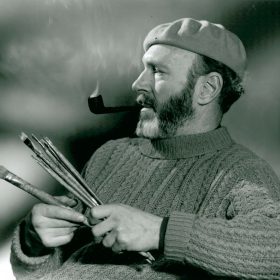Denis Peploe made a number of overtly fantastical paintings in the late seventies, including Alternative Hypothesis. The three central figures seem made of the same material as the arid, lunar landscape they inhabit, like Titans emerging from the interior of the planet at a place where a totem stands. Is this a place of worship? Or the birthplace of mankind, formed from the space dust from the origin of the universe? Peploe identified as agnostic, allowing for a spiritual element in his views without committing to a conventional theology. As a painter drawn to the mountains of Western Scotland he would have had much occasion to ponder the meaning of life in the face of the sublime.

Denis Peploe was born in 1914, the second son of the celebrated Scottish Colourist S J Peploe. Denis Peploe enrolled at Edinburgh College of Art at the age of seventeen where he was a contemporary of Wilhelmina Barns-Graham and Margaret Mellis. He won post-diploma scholarships to Paris and Florence and took advantage of opportunity to travel extensively in Spain, Italy and Yugoslavia. He first exhibited at The Scottish Gallery in 1947, to critical acclaim. The Glasgow Herald critic responded to the exhibition, saying he was “an artist born fully armed”; and The Bulletin critic wrote: “the general impression of the exhibition is that we have in Denis Peploe a vital and adventurous painter”. Reviewers never avoided mention of his father, and though one couldn’t confuse their work there were similarities in their approaches: each picture was a response to a particular subject, either intellectual or emotional. His son, Gallery Director, Guy Peploe explains:
‘While he was intimately exposed to the mainstream of European art he remained better defined as an artist who responded directly to his subject, en plein air or in the studio. Here the challenge was a live model, or the intellectual exercise of reinvigorating the still life subject. His work remained free of political or art-world references but was at the same time formed by the century of modernism, the times of unprecedented turmoil and change to which he belonged. His response was to cleave to the idea that art was important, even redemptive and that it could somehow describe a better, or more vital place.’
We would be delighted to hear from you if you are considering selling any works by Denis Peploe.